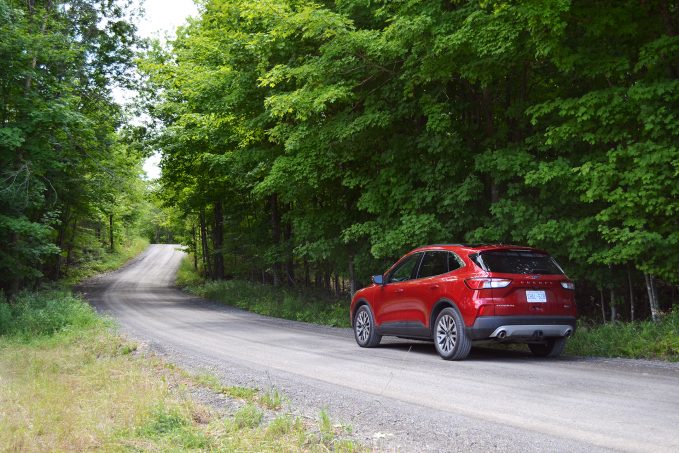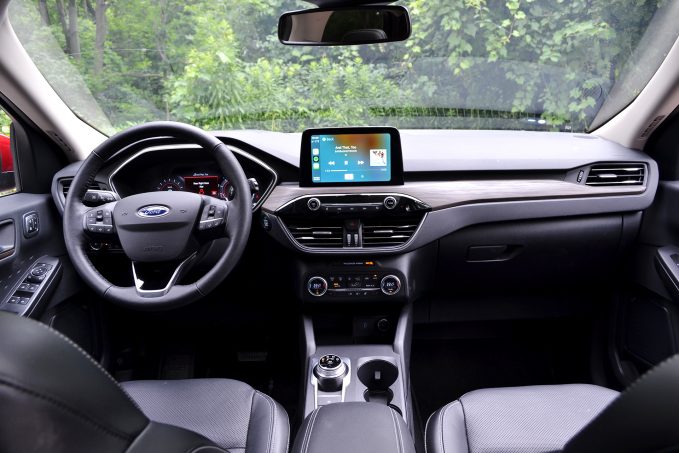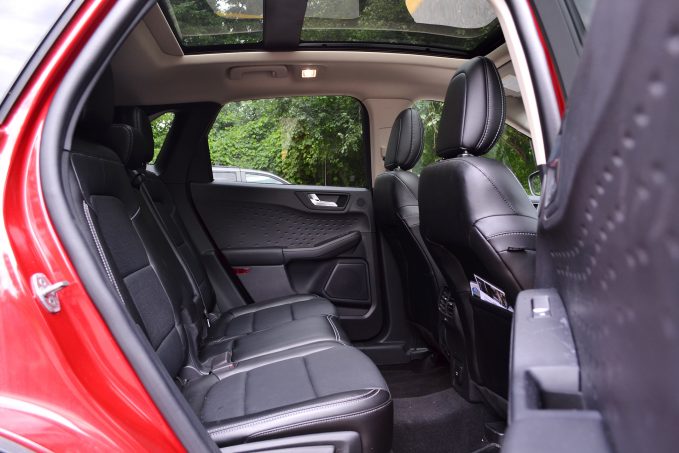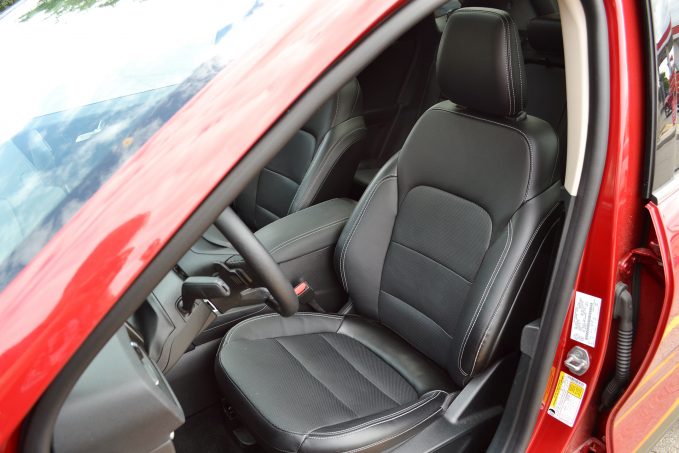Here in a post-Bronco world, Ford’s Escape now makes more sense.
When I drove the smaller-engined version of the Blue Oval’s bread and butter earlier this year, I knew the Bronco Sport was coming. But now that it has form, sharing the Escape’s engine lineup in a smaller—but no more affordable—package, the Bronco Sport has given the Escape purpose. The Escape is for the folks that want a family car, without having to call it a car, from the company that doesn’t build family cars anymore.
More power please
Selecting the highfalutin Titanium trim nets buyers the otherwise optional 2.0-liter EcoBoost engine as standard. I’m a big fan of the base triple-pot, and my first initial prods of the Titanium’s right pedal don’t immediately convince me the extra cylinder’s worth it. It’s the flatter power curve’s linear power delivery masking how much extra muscle this four-pot is packing: it’s deceptively quick. Put it up against a stop-watch and the difference becomes clearer. 250 horsepower makes the Escape one of the quickest in its class, helped even more by a stout 280 lb-ft. You’ll be the first crossover out of soccer practice, for sure.
The four-cylinder Escape rides with the same smooth character as the three-pot. It’s not sporting, but responds quickly and accurately to inputs. The lighter and stiffer platform swallows up bumps without sending much noise to the cabin, nor jiggling the folks within.

The larger-engined model uses the same eight-speed automatic as other Escapes, while also featuring wheel-mounted paddle shifters. The tiny plastic paddles don’t offer much tactile delight, but they’re effective for forcing engine braking on downhill sections. Otherwise, leaving the transmission to its own logic results in almost zero cog-hunting thanks to the extra power of the engine. You can always slip the Escape into Sport mode if you want the ‘box to hold onto extra revs, though it feels about as natural as your grandma wearing Nike high tops.
Perhaps most surprising to me is the Escape’s start-stop system; specifically, how low-key it is. When the engine awakes from its brief siesta, I barely notice.
The penalty at the pumps for the extra power is minimal. Over our week together the Escape managed 29 mpg combined, an improvement on the EPA-quoted 26 mpg average. For comparison, the 1.5-liter pulled off 32.6 mpg during a week of similar AutoGuide use.
Tons of Titanium tech

Thanks to its position at the top of the trim pile, the Titanium comes chock-full of useful tech. Clocking the all-digital instrument panel is an early positive. Crisp graphics make it easy to read, and its configurable nature allows a driver to easily tailor the available info to their liking. An optional head-up display is also present on my tester. Normally I’m a fan of HUDs, but the dedicated glass panel in the Escape is more distracting than the usual direct windshield projection, at least to my eyes. Your mileage may vary.
Being a family vehicle, the Escape Titanium comes with a bevy of standard safety features. Many of them, including automated emergency braking, blind-spot warning with rear cross-traffic alert, lane-keep assist, and auto high beams, are standard on every Escape. The Titanium trim adds adaptive cruise control with stop-and-go capability as well as voice-activated navigation. The system works well, keeping the Escape within its lane without the ping-ponging evident in other setups out there.
SEE ALSO: 2020 Ford Ranger FX4 Review
An 8.0-inch central touchscreen uses Ford’s reliable SYNC3 system. It’s a little pokey on initial startup but quick to respond afterwards. Apple CarPlay and Android Auto are both supported, via USB-C or USB-A. Unfortunately the plugs are only in the front row, limiting charging abilities for those in back.
Near the end of a weekend cottage trip, the system simply refused to acknowledge the presence of my iPhone via CarPlay, however. I unplugged it, restarted the phone, turned the car off and on, and never did solve it. The following morning it worked perfectly. Technology, man.
FordPass Connect is also standard, supplying a WiFi hotspot with up to 10 connections. It also allows you to check up on the car via a dedicated app, as well as lock or start it remotely. A 10-speaker Bang & Olufsen sound system is also standard.
Ample space for people and their things

Ford has stretched the Escape to be longer, lower and wider than the last model. Combine the increased dimensions with a car-on-stilts stance and it’s both easy to get into and suitably roomy. Ford quotes 40 inches of headroom in front and marginally less in the second row. Meanwhile, front legroom is a 42.4 inches; more than the Honda CR-V (41.3 in) and Toyota RAV4 (41.0 in), but less than the Subaru Forester and upcoming 2021 Nissan Rogue (both 43.3 in).
SEE ALSO: Nissan Rogue vs Honda CR-V vs Toyota RAV4 vs Ford Escape: How Does It Stack up?
Move to the back row and legroom is still ample for adults. What’s more, the row slides and reclines. This allows for a greater range of comfort for passengers, or for maximizing trunk space. Even with the seat slid forward, the Escape’s maximum 37.5 cubic feet of storage can’t match the CR-V’s 39.2. Blame the curvy tailgate for the Escape’s comparative lack of storage space. In truth, unless you’re regularly cramming it full of supplies, you won’t notice. The load floor is nice and low and the hatch opening is wide—though I’d like if it curved less aggressively at the bottom.
Drop the rear seats and you’ve got 65.4 cubes to play with. More likely to want to haul things outside of the Escape? The 2.0-liter is your tool of choice: when properly equipped, the all-wheel drive model will tow up to 3,500 lb (1,587 kg). That’s usefully more than nearly anything else in the class; only the Chevrolet Equinox and Jeep Cherokee out-tow it.
Chintzy interior details

My biggest gripe with the Escape’s interior isn’t the amount of space, but the quality of it. The dimpled door panels of the base model remain here, huge swaths of brittle-feeling black plastic that don’t feel appropriate on a range-topper. The lower center console around the cupholders feels similarly cheap, with only the silver-painted trim around the rotary gear selector breaking up all the black. The wood trim does its best to lift the ambiance, but I’d highly recommend selecting the Sandstone interior color option.
SEE ALSO: Ford Edge vs Escape: Which Ford Crossover is Better for You?
The leather seats are comfortable and widely adjustable, but don’t offer ventilation, only heating. (Neither heating nor cooling are available for second-row passengers as well.)
As mentioned earlier, there are no USB ports in the second row. Ford will be adding two more later in the year, but it feels like an oversight in a new-for-2020 model. At least the large panoramic glass roof—part of the Titanium Premium Package—lets a lot of light in back there.
Verdict: 2020 Ford Escape Titanium Review

My loaded tester rings in at $40,070 including destination (or $44,949 in Canada): the only options are paint ($395 / $450) and the Premium Package ($2,100 / $2,350) That’s a lot of money for a model that doesn’t comprehensively out-point the competition. The Mazda CX-5 is similarly pricey, but the better drive. The CR-V offers more space; the RAV4, more off-road looks—and, in TRD Off-Road trim, chops to back that up.
The Escape is the most car-like, however. That may seem like a drawback in SUV-crazy 2020, but on the flip-side, it’s what I believe many buyers truly want from their high-riders. The Escape offers the easy maneuverability and accessible power of a mid-size sedan with the higher-up seating position and added versatility of a modern SUV. Cheap plastics aside, it covers the vast Venn diagram of the compact crossover segment well, appealing to most users’ needs.



Leave a Reply